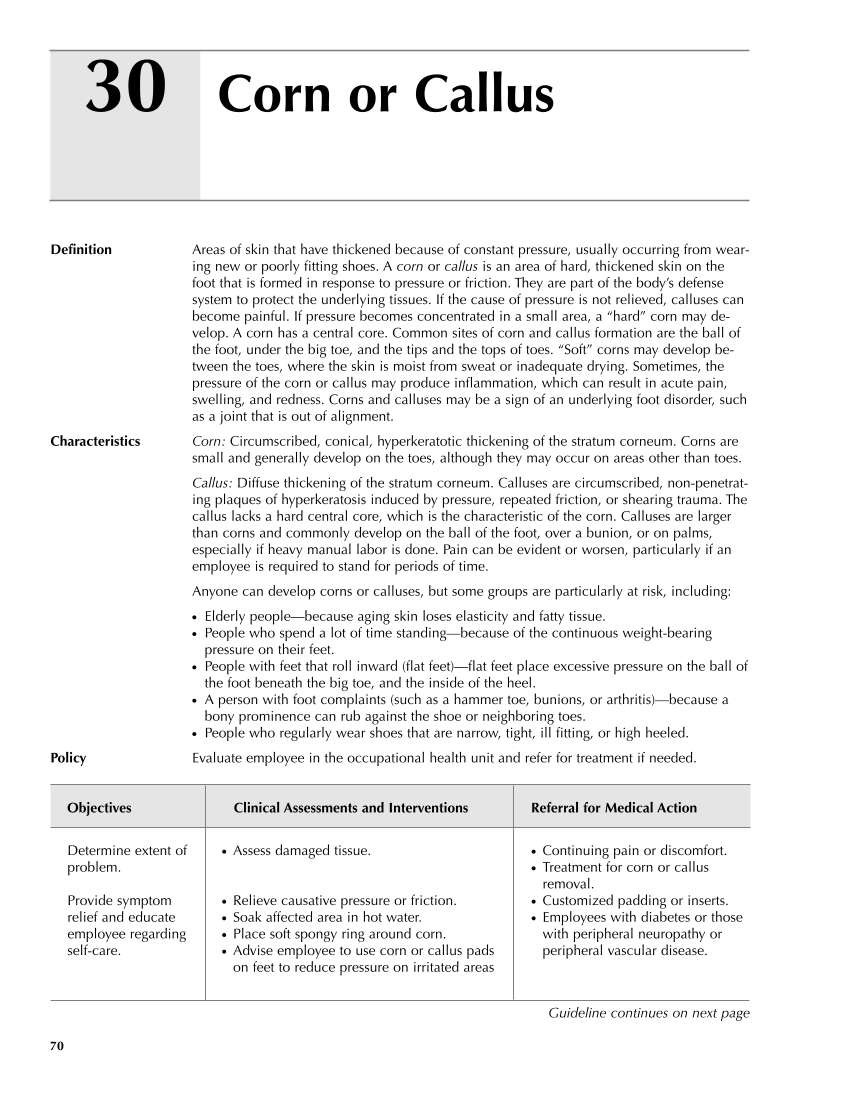30 70 Definition Areas of skin that have thickened because of constant pressure, usually occurring from wear- ing new or poorly fitting shoes. A corn or callus is an area of hard, thickened skin on the foot that is formed in response to pressure or friction. They are part of the body’s defense system to protect the underlying tissues. If the cause of pressure is not relieved, calluses can become painful. If pressure becomes concentrated in a small area, a “hard” corn may de- velop. A corn has a central core. Common sites of corn and callus formation are the ball of the foot, under the big toe, and the tips and the tops of toes. “Soft” corns may develop be- tween the toes, where the skin is moist from sweat or inadequate drying. Sometimes, the pressure of the corn or callus may produce inflammation, which can result in acute pain, swelling, and redness. Corns and calluses may be a sign of an underlying foot disorder, such as a joint that is out of alignment. Characteristics Corn: Circumscribed, conical, hyperkeratotic thickening of the stratum corneum. Corns are small and generally develop on the toes, although they may occur on areas other than toes. Callus: Diffuse thickening of the stratum corneum. Calluses are circumscribed, non-penetrat- ing plaques of hyperkeratosis induced by pressure, repeated friction, or shearing trauma. The callus lacks a hard central core, which is the characteristic of the corn. Calluses are larger than corns and commonly develop on the ball of the foot, over a bunion, or on palms, especially if heavy manual labor is done. Pain can be evident or worsen, particularly if an employee is required to stand for periods of time. Anyone can develop corns or calluses, but some groups are particularly at risk, including: ● Elderly people—because aging skin loses elasticity and fatty tissue. ● People who spend a lot of time standing—because of the continuous weight-bearing pressure on their feet. ● People with feet that roll inward (flat feet)—flat feet place excessive pressure on the ball of the foot beneath the big toe, and the inside of the heel. ● A person with foot complaints (such as a hammer toe, bunions, or arthritis)—because a bony prominence can rub against the shoe or neighboring toes. ● People who regularly wear shoes that are narrow, tight, ill fitting, or high heeled. Policy Evaluate employee in the occupational health unit and refer for treatment if needed. Objectives Clinical Assessments and Interventions Referral for Medical Action Corn or Callus ● Continuing pain or discomfort. ● Treatment for corn or callus removal. ● Customized padding or inserts. ● Employees with diabetes or those with peripheral neuropathy or peripheral vascular disease. Determine extent of problem. Provide symptom relief and educate employee regarding self-care. ● Assess damaged tissue. ● Relieve causative pressure or friction. ● Soak affected area in hot water. ● Place soft spongy ring around corn. ● Advise employee to use corn or callus pads on feet to reduce pressure on irritated areas Guideline continues on next page
Purchased from OEM Press by (ge corporate access). (C) 2013 OEM Health Information, Inc. All rights reserved.












































































































































































































































































































































































































































